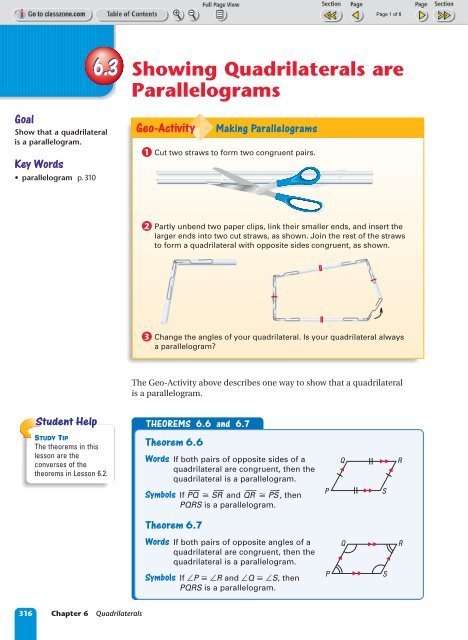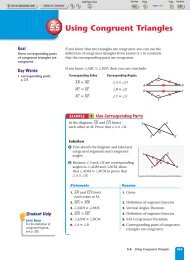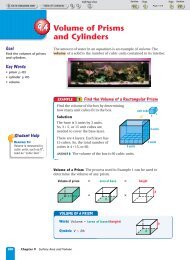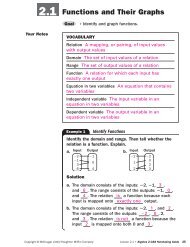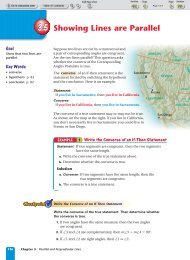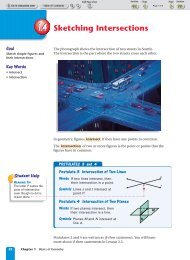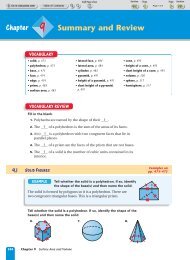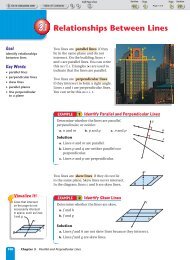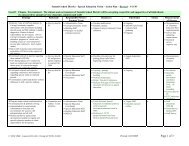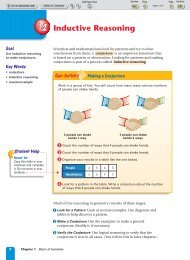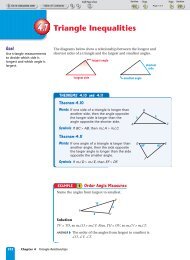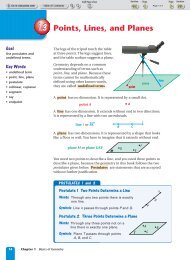6.3 Showing Quadrilaterals are Parallelograms
6.3 Showing Quadrilaterals are Parallelograms
6.3 Showing Quadrilaterals are Parallelograms
Create successful ePaper yourself
Turn your PDF publications into a flip-book with our unique Google optimized e-Paper software.
Goal<br />
Show that a quadrilateral<br />
is a parallelogram.<br />
Key Words<br />
• parallelogram p. 310<br />
Student Help<br />
STUDY TIP<br />
The theorems in this<br />
lesson <strong>are</strong> the<br />
converses of the<br />
theorems in Lesson 6.2.<br />
316 Chapter 6 <strong>Quadrilaterals</strong><br />
<strong>6.3</strong> <strong>Showing</strong> <strong>Quadrilaterals</strong> <strong>are</strong><br />
<strong>Parallelograms</strong><br />
Geo-Activity<br />
Making <strong>Parallelograms</strong><br />
●1 Cut two straws to form two congruent pairs.<br />
●2 Partly unbend two paper clips, link their smaller ends, and insert the<br />
larger ends into two cut straws, as shown. Join the rest of the straws<br />
to form a quadrilateral with opposite sides congruent, as shown.<br />
●3 Change the angles of your quadrilateral. Is your quadrilateral always<br />
a parallelogram?<br />
The Geo-Activity above describes one way to show that a quadrilateral<br />
is a parallelogram.<br />
THEOREMS 6.6 and 6.7<br />
Theorem 6.6<br />
Words If both pairs of opposite sides of a<br />
quadrilateral <strong>are</strong> congruent, then the<br />
quadrilateral is a parallelogram.<br />
Symbols If PQ&* c SR&* and QR&* c PS&*, then<br />
PQRS is a parallelogram.<br />
Theorem 6.7<br />
Words If both pairs of opposite angles of a<br />
quadrilateral <strong>are</strong> congruent, then the<br />
quadrilateral is a parallelogram.<br />
Symbols If aP caR and aQ caS, then<br />
PQRS is a parallelogram.<br />
P<br />
P<br />
P<br />
P<br />
S<br />
S<br />
R<br />
R
IStudent Help<br />
I CLASSZONE.COM<br />
MORE EXAMPLES<br />
More examples at<br />
classzone.com<br />
EXAMPLE 1 Use Opposite Sides<br />
Tell whether the quadrilateral is a<br />
parallelogram. Explain your reasoning.<br />
Solution<br />
The quadrilateral is not a parallelogram. It has two pairs<br />
of congruent sides, but opposite sides <strong>are</strong> not congruent.<br />
EXAMPLE 2 Use Opposite Angles<br />
Tell whether the quadrilateral is a<br />
parallelogram. Explain your reasoning.<br />
140<br />
Solution<br />
The quadrilateral is a parallelogram because both pairs of<br />
opposite angles <strong>are</strong> congruent.<br />
Use Opposite Sides and Opposite Angles<br />
In Exercises 1 and 2, tell whether the quadrilateral is a parallelogram.<br />
Explain your reasoning.<br />
1. D 5 C<br />
2.<br />
4<br />
A<br />
5<br />
4<br />
B<br />
3. In quadrilateral WXYZ, WX 15, YZ 20, XY 15, and ZW 20.<br />
Is WXYZ a parallelogram? Explain your reasoning.<br />
THEOREM 6.8<br />
Words If an angle of a quadrilateral is<br />
supplementary to both of its<br />
consecutive angles, then the<br />
quadrilateral is a parallelogram.<br />
Symbols If maP maQ 180 and maQ maR 180,<br />
then PQRS is a parallelogram.<br />
L<br />
K<br />
<strong>6.3</strong> <strong>Showing</strong> <strong>Quadrilaterals</strong> <strong>are</strong> <strong>Parallelograms</strong> 317<br />
40<br />
P<br />
y<br />
140<br />
P<br />
x<br />
x y 180<br />
S<br />
x<br />
40<br />
M<br />
J<br />
R
318 Chapter 6 <strong>Quadrilaterals</strong><br />
EXAMPLE 3 Use Consecutive Angles<br />
Tell whether the quadrilateral is a parallelogram. Explain your<br />
reasoning.<br />
a. U<br />
V b. E F c.<br />
95<br />
85<br />
125<br />
T<br />
85<br />
Solution<br />
W<br />
120 55<br />
H G<br />
B C<br />
A D<br />
a. aU is supplementary to aT and aV (8595180). So, by<br />
Theorem 6.8, TUVW is a parallelogram.<br />
b. aG is supplementary to aF (55125180), but aG is not<br />
supplementary to aH (55120180). So, EFGH is not a<br />
parallelogram.<br />
c. aD is supplementary to aC (9090180), but you <strong>are</strong> not<br />
given any information about aA or aB. Therefore, you cannot<br />
conclude that ABCD is a parallelogram.<br />
THEOREM 6.9<br />
Words If the diagonals of a quadrilateral<br />
bisect each other, then the<br />
quadrilateral is a parallelogram.<br />
Symbols If QM&* cMS &*** and PM &** c MR &**,<br />
then PQRS is a parallelogram.<br />
EXAMPLE 4 Use Diagonals<br />
Tell whether the quadrilateral is a parallelogram. Explain your<br />
reasoning.<br />
a. b.<br />
J K<br />
19<br />
18 19<br />
M L<br />
Solution<br />
18<br />
a. The diagonals of JKLM bisect each other. So, by Theorem 6.9,<br />
JKLM is a parallelogram.<br />
b. The diagonals of PQRS do not bisect each other. So, PQRS is<br />
not a parallelogram.<br />
S<br />
P<br />
P<br />
4<br />
2<br />
P<br />
3<br />
3<br />
R<br />
M<br />
P<br />
S<br />
R
Use Consecutive Angles and Diagonals<br />
Tell whether the quadrilateral is a parallelogram. Explain your<br />
reasoning.<br />
4. G 5.<br />
80<br />
H<br />
130<br />
E<br />
60<br />
F<br />
L M<br />
104<br />
76 104<br />
K N<br />
6. R P<br />
7. U V<br />
T<br />
5<br />
4<br />
X<br />
5<br />
4<br />
S<br />
P<br />
T<br />
W<br />
You have learned five ways to show that a quadrilateral is a<br />
parallelogram.<br />
SUMMARY<br />
SHOWING A QUADRILATERAL IS A PARALLELOGRAM<br />
Definition of parallelogram, p. 310<br />
Show that both pairs of opposite sides<br />
<strong>are</strong> parallel.<br />
Theorem 6.6, p. 316<br />
Show that both pairs of opposite sides<br />
<strong>are</strong> congruent.<br />
Theorem 6.7, p. 316<br />
Show that both pairs of opposite angles<br />
<strong>are</strong> congruent.<br />
Theorem 6.8, p. 317<br />
Show that one angle is supplementary<br />
to both of its consecutive angles.<br />
Theorem 6.9, p. 318<br />
Show that the diagonals bisect<br />
each other.<br />
y x<br />
<strong>6.3</strong> <strong>Showing</strong> <strong>Quadrilaterals</strong> <strong>are</strong> <strong>Parallelograms</strong> 319<br />
x<br />
x y 180
<strong>6.3</strong><br />
Exercises<br />
Guided Practice<br />
Vocabulary Check<br />
Practice and Applications<br />
Extra Practice<br />
See p. 685.<br />
Skill Check<br />
Homework Help<br />
Example 1: Exs. 8–10<br />
Example 2: Exs. 11–13<br />
Example 3: Exs. 14–16<br />
Example 4: Exs. 17–19<br />
320 Chapter 6 <strong>Quadrilaterals</strong><br />
In Exercises 1–3, name all the sides or angles of gEFGH that match<br />
the description.<br />
1. Opposite sides <strong>are</strong> parallel.<br />
2. Opposite angles <strong>are</strong> congruent.<br />
3. Consecutive angles <strong>are</strong> supplementary.<br />
4. Explain why every parallelogram is a quadrilateral, but not every<br />
quadrilateral is a parallelogram.<br />
Decide whether you <strong>are</strong> given enough information to show that the<br />
quadrilateral is a parallelogram. Explain your reasoning.<br />
5.<br />
50<br />
6. 7.<br />
6<br />
6<br />
Using Opposite Sides Tell whether the quadrilateral is a<br />
parallelogram. Explain your reasoning.<br />
8. 9. 10.<br />
8 6<br />
Using Opposite Angles Tell whether the quadrilateral is a<br />
parallelogram. Explain your reasoning.<br />
11. 12. 13.<br />
82 98<br />
98<br />
130<br />
Using Consecutive Angles Tell whether the quadrilateral is a<br />
parallelogram. Explain your reasoning.<br />
14.<br />
60 120<br />
15. 16.<br />
120<br />
82<br />
6<br />
118<br />
72<br />
8<br />
118<br />
H<br />
E<br />
80<br />
3<br />
3<br />
G<br />
110<br />
2<br />
2<br />
F<br />
110 60
Bicycles<br />
DERAILLEURS (named from<br />
the French word meaning<br />
“to derail”) move the chain<br />
to change gears.<br />
Application Links<br />
CLASSZONE.COM<br />
Using Diagonals Tell whether the quadrilateral is a parallelogram.<br />
Explain your reasoning.<br />
17. 18. 19.<br />
20. Bicycle Gears When you change<br />
gears on a bicycle, the derailleur<br />
moves the chain to the new gear.<br />
For the derailleur at the right,<br />
AB 1.8 cm, BC 3.6 cm,<br />
CD 1.8 cm, and DA 3.6 cm.<br />
Explain why AB&* and CD &** <strong>are</strong> always<br />
parallel when the derailleur moves.<br />
21. Error Analysis What is wrong with the student’s argument below?<br />
A quadrilateral that has one pair<br />
of sides congruent and the other<br />
pair of sides parallel is always a<br />
parallelogram.<br />
You be the Judge<br />
22. Three of the interior angles of a<br />
quadrilateral have measures of 75, 75, and 105. Is this enough<br />
information to conclude that the quadrilateral is a parallelogram?<br />
Explain your answer.<br />
23. Visualize It! Explain why the following method of drawing a<br />
parallelogram works. State a theorem to support your answer.<br />
●1 Use a ruler to draw ●2 Draw another ●3<br />
a segment and its<br />
midpoint.<br />
segment so the<br />
midpoints coincide.<br />
6 4<br />
7<br />
5<br />
B C<br />
A D<br />
Connect the<br />
endpoints of the<br />
segments.<br />
24. Challenge If one pair of opposite sides of a quadrilateral is both<br />
congruent and parallel, is the quadrilateral a parallelogram?<br />
Explain your reasoning.<br />
<strong>6.3</strong> <strong>Showing</strong> <strong>Quadrilaterals</strong> <strong>are</strong> <strong>Parallelograms</strong> 321
Student Help<br />
SKILLS REVIEW<br />
To review the formula<br />
for finding slope, see<br />
p. 665.<br />
Standardized Test<br />
Practice<br />
322 Chapter 6 <strong>Quadrilaterals</strong><br />
EXAMPLE Coordinate Geometry<br />
Use the slopes of the segments in<br />
the diagram to determine if the<br />
quadrilateral is a parallelogram.<br />
Solution<br />
Lines and line segments <strong>are</strong> parallel<br />
if they have the same slope.<br />
Slope of AB&*: 4 0<br />
<br />
2 1<br />
4<br />
4<br />
1<br />
0<br />
Slope of DC &*: 4 <br />
6 5<br />
4<br />
A(1, 0) 4 D(5, 0) x<br />
4<br />
1<br />
Slope of BC&*: 4 4<br />
<br />
6 2<br />
0<br />
0<br />
0 Slope of AD&*: 0 <br />
4 5 1<br />
0<br />
0<br />
4<br />
ANSWER The slopes of AB&* and DC &* <strong>are</strong> the same, so AB&* DC &*. The<br />
slopes of BC&*and AD&* <strong>are</strong> the same, so AD&* BC&*. Both pairs<br />
of opposite sides <strong>are</strong> parallel, so ABCD is a parallelogram.<br />
1<br />
y<br />
B(2, 4) C(6, 4)<br />
Coordinate Geometry Use the slopes of the segments in the<br />
diagram to determine if the quadrilateral is a parallelogram.<br />
25. y<br />
26.<br />
1<br />
G(1, 4) H(5, 4)<br />
F(2, 1)<br />
1<br />
J(6, 1)<br />
27. Multi-Step Problem Suppose you shoot a pool ball as shown<br />
below and it rolls back to where it started. The ball bounces off<br />
each wall at the same angle at which it hits the wall.<br />
a. The ball hits the first wall at an angle of 63.<br />
So maAEF maBEH 63. Explain why maAFE 27.<br />
b. Explain why maFGD 63.<br />
c. What is maGHC? maEHB?<br />
x<br />
d. Find the measure of each interior angle of EFGH. What kind<br />
of quadrilateral is EFGH? How do you know?<br />
1<br />
y<br />
P(0, 2)<br />
1<br />
Œ(2, 5) R(5, 5)<br />
S(4, 2)<br />
x
Quiz 1<br />
Mixed Review<br />
Algebra Skills<br />
Finding Angle Measures Find the measure of aA. (Lesson 6.1)<br />
28.<br />
D<br />
99<br />
A 29.<br />
A<br />
B<br />
70<br />
30.<br />
D<br />
110<br />
A<br />
C<br />
85 101<br />
B<br />
114<br />
D<br />
C<br />
C<br />
82 78<br />
B<br />
Finding Measures Find the measure in gJKLM. (Lesson 6.2)<br />
31. Find maK. 32. Find maJ.<br />
33. Find ML. 34. Find KL.<br />
Evaluating Expressions Evaluate the expression for the given value<br />
of the variable. (Skills Review, p. 670)<br />
35. 2x 7 when x 5 36. 4y 3 when y 2<br />
37. 13 3m when m 3 38. 1 b when b 10<br />
39. 5 2a when a 6 40. 8c 5 when c 4<br />
41. 12x x 2 when x 1 42. 3<br />
4 q2 2 when q 4<br />
43. 5n 3 4n when n 2 44. 15p p 2 when p 3<br />
Decide whether the figure is a polygon. If so, tell what type. If not,<br />
explain why. (Lesson 6.1)<br />
1. 2. 3.<br />
Find the values of the variables in the parallelogram. (Lesson 6.2)<br />
4. y<br />
5. x y<br />
6.<br />
16<br />
15<br />
x<br />
Tell whether the quadrilateral is a parallelogram. Explain your<br />
reasoning. (Lesson <strong>6.3</strong>)<br />
7.<br />
65<br />
8. 9.<br />
130 50<br />
115 65<br />
122 z<br />
K<br />
<strong>6.3</strong> <strong>Showing</strong> <strong>Quadrilaterals</strong> <strong>are</strong> <strong>Parallelograms</strong> 323<br />
L<br />
14<br />
x<br />
M<br />
71<br />
11<br />
J<br />
y<br />
12<br />
9


